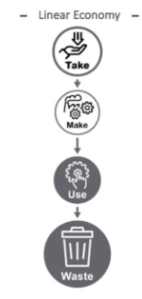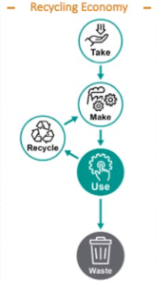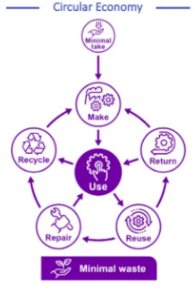ForumIAS announcing GS Foundation Program for UPSC CSE 2025-26 from 19 April. Click Here for more information.
Contents
- 1 Introduction
- 2 What is Circular economy? How is it different from the other economic production-consumption models?
- 3 What are the benefits of Circular Economy?
- 4 What steps have been taken to promote circular economy?
- 5 What are the Challenges in achieving Circular Economy ?
- 6 Conclusion and Way forward
| For 7PM Editorial Archives click HERE → |
Introduction
The concept of Circular economy has gained momentum in recent times and is here to stay. With the environment and climate at the verge of catastrophes, ‘circular economy’ has already earned the status of a powerful antidote for preventing the worst from happening, or at least for lessening the negative impacts.
This concept has entered the scientific debate and the jargon of politicians, entrepreneurs and civil society. It has become an important policy priority. India recognised the need for it and launched the Resource Efficiency and Circular Economy Industry Coalition (RECEIC) under its G20 presidency.
| Read More- Resource Efficiency Circular Economy Industry Coalition |
What is Circular economy? How is it different from the other economic production-consumption models?
Circular Economy- It is an economic model of production and consumption, which involves sharing, leasing, reusing, repairing, refurbishing and recycling existing materials and products for as long as possible. This in turn extends the life cycle of the product.
Three economic production-consumption models- Compared
| Linear Economy | Recycling Economy | Circular Economy |
| It is a ‘take-make-consume-waste‘ model. There is no focus on either recycling or reduction. The model relies on large quantities of cheap, easily accessible materials and energy. | It is a ‘take-make-consume-waste-recycle‘ model. The model focuses on recycling of the end products for reuse. This model was an advancement over the linear economy model with the introduction of recycling. | It is a ‘reduce-reuse-recycle-refurbishment-recover-repair‘ model. The model focuses on reduction of waste in the first place and minimisation of the need for recycling. For ex- Use of microbial biodegradable polymers produced from agri-food waste for packaging of food items. This will eliminate use of plastics and the need of recycling. |
What are the benefits of Circular Economy?
1. Transformation of the Current Throwaway economic model- According to the Circularity Gap Report 2020, the global economy is only 8.6% circular. This means that over 90% of the 100 billion tonnes of resources that enter the economy per year are wasted. Adoption of Circular economic model eliminates wastage and increases the circulation of resources.
2. Increase in employment opportunities- Circular Economy fosters the development of a new, more inventive, and competitive industrial model. This can result in higher economic growth and more employment opportunities. For ex- According to NITI Aayog, in the next 5–7 years, this circular economic model has the potential to produce 1.4 crore employment and lakhs of new businesses like waste to energy.
3. Reduced reliance on imports- Reuse of local resources reduces reliance on imported raw materials and helps in achieving self-sufficiency. This fulfils our vision of Aatmanirbhar Bharat. For Ex- Used newspapers for making plates and use of earthen lamps in place of electric lights.
4. Protection of the environment-
a. Circular economy benefits the environment by consuming fewer natural resources and reducing the generation of waste. For ex- According to the Central Pollution Control Board (CPCB), India generates over 62 million tonnes of waste every year. Most of this waste is disposed of in landfills or dumped in open spaces, leading to environmental degradation and health hazards.
b. It helps in preservation of biodiversity and reduces the pressure on natural resources like forests. For Ex- Decreased mining in forest areas.
5. Achieving the sustainable Development goals- Adoption of this economic model leads to the adoption of responsible production and consumption patterns (SDG 12).
What steps have been taken to promote circular economy?
The Government of India is putting special emphasis on the importance of the circular
economy, resource efficiency, and sustainable consumption and production.
Mission LiFE, launched by India in October 2022, seeks to promote circular economy by reshaping demand, rethinking supply and developing a responsive ecosystem.
Some of the other key initiatives taken by India, to promote the circular economic model are mentioned below:
| 1. National Resource Efficiency Policy (NREP)- The NREP was launched in 2019 with the objective of promoting sustainable production and consumption patterns, enhancing resource efficiency, and reducing the environmental impact of economic activities. Steel scrap recycling policy and Vehicle scrapping policy have also been launched with the same objectives. 2. Extended Producer Responsibility (EPR)- EPR is a regulatory framework that makes manufacturers and producers responsible for the post-consumer waste generated by their products. The Government has notified various rules, such as the Plastic Waste Management Rules, e-Waste Management Rules, Construction and Demolition Waste Management Rules, Metals Recycling Policy. 3. Bio-Economy and Biofuels- Pradhan Mantri JI-VAN Yojana, Galvanizing Organic Bio-Agro Resources (GOBAR) Dhan scheme and Sustainable Alternative Towards Affordable Transportation (SATAT) Scheme, promote circular economy in the agricultural sector by converting agri-waste into ethanol and compressed Bio-gas (CBG). 4. Initiatives of NITI Aayog- NITI Aayog has taken initiatives to address the challenges in the utilization of waste as resource. For ex- Promotion of the usage of fly ash and slag produced in the steel industry in other sectors. |
Other international initiatives and Case Studies for Circular Economy
| 1. China, Germany and Japan- China has enacted the Circular Economy Promotion Law. Germany and Japan have used this model as a binding principle for reorganising their economies. 2. Global Alliance on Circular economy and Resource Efficiency (GACERE)- It was launched in 2021 and is supported by UNEP and UNIDO. India is a member of GACERE. It advocates for a global circular economy transition. 3. Resource Efficiency and Circular Economy Industry Coalition (RECEIC)- Mentioned above. |
What are the Challenges in achieving Circular Economy ?
1. Unclear Vision for Circular Economy- Currently the efforts for promotion of this economic model are being made at the very end of value chains at the recycling stage. This has resulted in suboptimal economic and environmental outcomes.
2. Reluctance of Industries- The Industries have been reluctant in adopting this model due to supply chain limitations, complex recycling processes and lack of incentives in investments for circular economy.
3. Infrastructure Challenges- Currently, India’s infrastructure is not well-suited to support a circular economy. For ex- there is lack of adequate recycling facilities, which makes it difficult to recycle and reuse materials.
4. Cultural Challenges- There is a cultural resistance to the idea of reusing and recycling products in India, making it difficult to change consumer behaviour and shift towards a circular economy. For Ex- Discarding the clothes of deads, in India, contributes to increase in lifestyle related pollution.
5. Growth of consumerism and materialism- The growth of consumerism and materialism has increased the resource extraction and wastages. For ex- Discarding iPhones every year for a new iPhone.
Conclusion and Way forward
1. Develop a comprehensive circular economy policy- India needs to create a comprehensive policy framework that outlines the goals, strategies and mechanisms to transition towards a circular economy.
2. Increase the investment in innovation and technology- India should invest in innovation and technology to develop new circular solutions, such as advance recycling technologies, sustainable materials and renewable energy sources.
3. Shift of focus of our efforts for Circular economy- The focus of Indian Government has been more on recycling till now. Now, the focus of the circular economic model, must shift to the design and manufacturing stage.
4. Encourage sustainable production and consumption- Government should encourage the production and consumption of sustainable products and services through tax incentives, product labelling and awareness campaigns.
5. Promote waste reduction and management- Government needs to focus on reducing waste generation and managing waste more efficiently. These can include measures such as promotion of recycling, composting, and waste-to-energy conversion. This would in turn benefit the local community.
India must take proactive steps to accelerate the transition to a circular economy, including investing in infrastructure, encouraging innovation and technology development, and building public awareness and support for a circular economy.
| Read More- The economic Times UPSC Syllabus- GS III- Conservation, Environment Pollution and Degradation |







